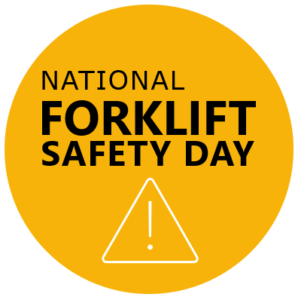 Is the material handling equipment in your warehouse safe and reliable?
Is the material handling equipment in your warehouse safe and reliable?
June 13 marks the 10th anniversary of National Forklift Safety Day. The Industrial Truck Association first initiated the day to educate customers, policymakers, and government officials about the safe use of forklifts and the importance of proper operator training.
Forklift safety is an important topic, as OSHA estimates that more than 1.5 million workers in the U.S. operate industrial trucks like forklifts. One of the most common causes of workplace injuries and fatalities, forklifts are responsible for an estimated 35,000 serious injuries and 62,000 non-serious injuries annually. Yet, according to OSHA, 70% of these accidents could be prevented with additional operator training and better forklift operation procedures.
Keeping employees safe is a fundamental part of any warehouse operation and requires educating workers on the topic and providing them with reliable equipment. Distributors must ensure that all equipment – especially forklifts – is maintained and meets OSHA safety standards. This starts with daily maintenance checks to verify that employees are using equipment that’s safe and adequately maintained, which goes a long way toward achieving the goals of National Forklift Safety Day.
PathGuide recently introduced a new module for Latitude WMS – Equipment Tracking and Safety Checks – to make this task easier for distributors to manage. This new module introduces automated prompts to check machinery, like forklifts, for pre-defined safety standards before the start of each shift. In accordance with OSHA regulations, this helps distributors implement workplace safety and reliability standards.
Let’s examine two key features and how they can minimize risk and improve safety for employees operating material handling equipment.
-
Pre-Shift Safety Checks:
The Equipment Tracking and Safety Checks module prompts employees for the equipment ID of the machinery they are preparing to operate upon login. If an employee still needs to perform a safety check on the equipment that day, the user must immediately conduct a check before using it. You can assign a customizable list of safety checks for each piece of equipment. The equipment operator records the safety checks, and alerts are automatically triggered if an entry is flagged as defective. Users can also add attachments or notes when conducting and recording the safety check. Moreover, you can view a history of past safety checks at any time.
-
Electronic Recordkeeping:
The Equipment Tracking and Safety Checks module also verifies and discloses a worker’s actions, showing what happened while someone was operating the machinery. In the case of a forklift, the module allows users to research or share equipment issues or malfunctions that could lead to safety issues. Examples of safety issues the module might identify could include a broken horn, malfunctioning brakes, or a faulty lift mechanism. Recordkeeping also protects your organization by demonstrating a daily commitment to the maintenance and safety of your equipment. Having insight into issues and retaining a log of when parts need replacement, maintenance requires completion, or repairs keeps employees and employers safe from malfunctioning equipment.
Beyond worker safety and well-being, daily equipment tracking and safety checks provide distributors with two other benefits:
-
Employee & Customer Satisfaction:
Prevention-focused tasks help avoid workplace injuries and lower worker comp claims while improving employee productivity. Safe equipment also boosts morale and shows workers you care. It’s no secret that employees are more likely to stick around when they believe their company has their well-being in mind and invests in their workplace and equipment. Satisfied workers also increase customer satisfaction because you can count on those employees to have fewer delays in order fulfillment. In addition, because the equipment safety checks are automated, they ultimately help you save time and resources.
-
Reduced Warehouse Expenses:
Equipment can go down anytime, and chances are it won’t happen at a time that’s convenient for you. These failures take longer to fix than performing a simple, automated equipment and safety checks each day. Routine maintenance is a relatively small investment for protection from mechanical issues that could cause safety hazards. Daily equipment monitoring provides valuable insight into how a machine works – before a problem can snowball into a more significant concern. Well-maintained equipment lasts longer, keeps workers safer, and results in a more efficient working environment, significantly decreasing warehouse expenses.
According to OSHA, employers must provide employees access to safe tools and equipment and confirm that this equipment is maintained correctly. Forklifts, in particular, require regular upkeep to ensure they function safely. Preventative measures like daily equipment safety checks can help provide peace of mind while promoting smooth warehouse operation.
As we reflect on this 10th anniversary of National Forklift Safety Day, let’s keep in mind the potential hazards employees face in the fast-paced warehousing and storage industry. Staying on top of your equipment and performing safety checks means your employees feel safe and stay safe. And that’s something everyone can feel good about.

 Is the material handling equipment in your warehouse safe and reliable?
Is the material handling equipment in your warehouse safe and reliable?